| Home > Policy > White Paper, Notice, Announcement > White Paper > Annual Report on the Promotion of Science and Technology 2002 > Part1 Chapter3 Section4 3 | ||
In today's environment where we have competition on a global
scale that is advancing, countries throughout the world are working to promote
strategic technical development policies centering on patent policy, and in Japan
too the creation of an intellectual property strategy is a pressing issue.
| (Review) |
In contrast to the US, where the first action period, the period of time from patent application to when the first notification is sent from the examiner to the applicant, is around 13 months, in Japan in recent years, it takes on average 21 months after placing a request for examination. The Patent Office is therefore working to strengthen the framework by increasing the number of examiners and utilizing external examination capacity for prior art examinations, in a bid to achieve rapid and accurate examinations ( Table 26 ).
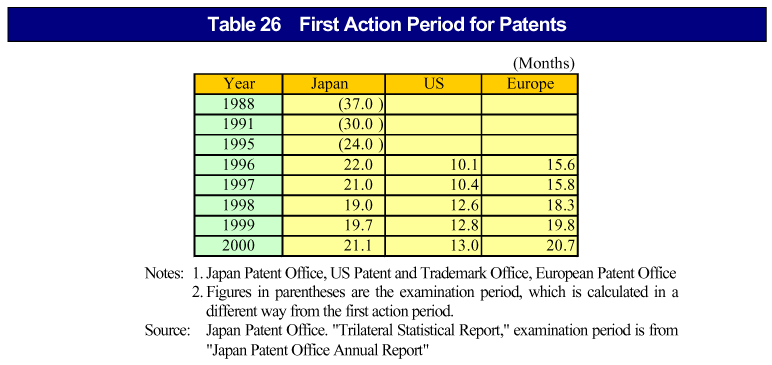
| (Dispute Settlement) |
The increasingly long times required for settlement of disputes concerning patents and so forth is a major problem, especially for products with short times before other companies will catch up. With regard to intellectual property cases, a specialist processing framework has been established in the courts, so the average trial times have been halved over the past ten years. It is hoped that further steps will be taken to strengthen the framework concerning intellectual property cases in the courts.
In patent law, due to the invention in service system the rights are passed on to companies, but against the backdrop of changes in employment practices in recent years, disputes are occurring concerning due consideration. With regard to the invention in service system, there is a need for companies to review appropriate measures based on treatment by contracts and rules of employment and the various practical customs.
In the future, it is important that the required review takes
place for these issues, and that efforts be made to promote reductions in the
processing cost and speeding up of dispute settlement concerning intellectual
property rights.
With the increasing importance of intellectual property rights, it is hoped that utilization of patents based on outstanding concepts of university researchers will be promoted, that research activities will be promoted by the results of their implementation being returned appropriately to inventors and universities, and that new research achievements will be generated, having broad implications for society.
However, while they are increasing as a whole in Japan, it is estimated that compared to universities in the West, the number of patent applications by universities is still small. One reason for this is that in the evaluation of researchers, publication of research papers and presentation at academic conferences is given priority, so there was a low level of interest in intellectual property rights as a direct motivation to carry out research in the first place.
In a situation in which there are few patents generated by universities, even if university researchers are interested in patents, the burden of procedures surrounding the acquisition of patents and the complexity of rules concerning ownership have an affect on patents received and utilized ( Fig. 27 , Fig. 28 ). The Second-term Science and Technology Basic Plan, advocates promoting the more efficient and effective utilization of research and development achievements, and a shift to promotion of utilization based on the principle of research organization management.
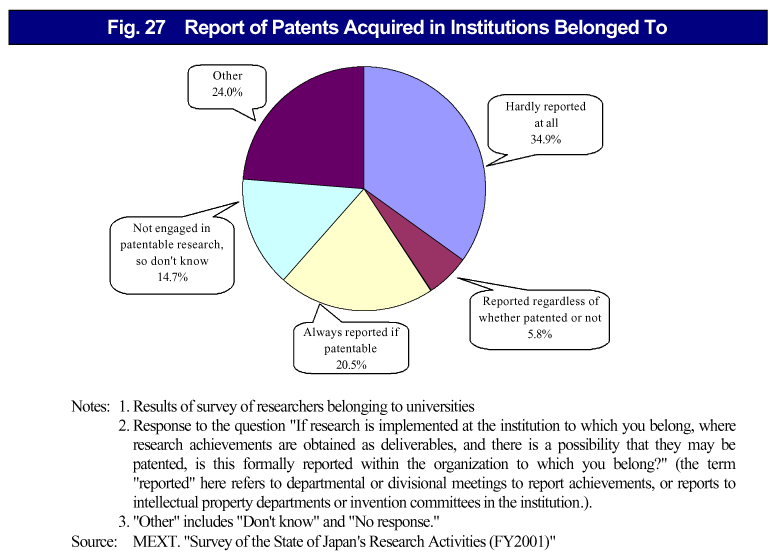
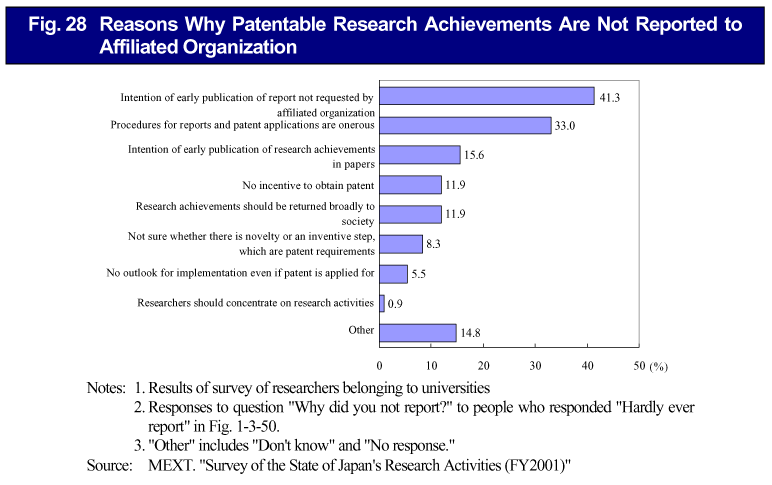
In universities, the utilization of patents owned by individuals
has been promoted by TLOs, but with regard to the future treatment of intellectual
property in universities, review is taking place about policies to promote the
utilization of patents, such as having them belong to corporatized national universities.
| (State of Patent Applications) |
The state of patent applications for Japanese companies is that up until recent years the number of domestic applications was greater than overseas applications, and with regard to the evaluation of patents possessed by own companies, patents of improvement are reported to account for more than 70% of applications ( Fig. 29 ). In addition, of the number of patents currently in existence (1.04 million in 2000), some two-thirds are estimated to be non-implemented, with the main reasons being defensive applications, changes to corporate management and technical development policy, and discovery or invention of substitute technology.
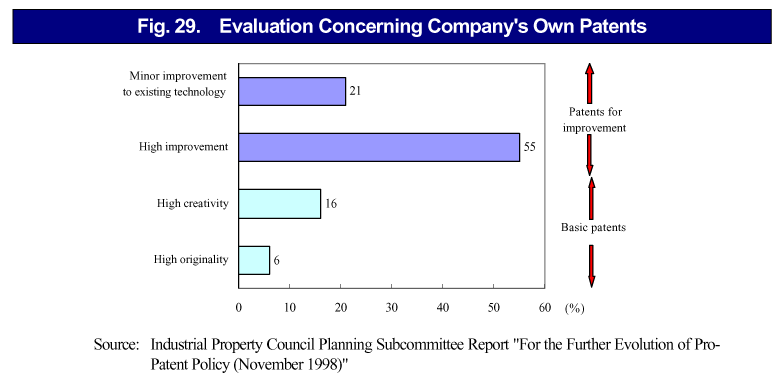
This can be attributed to the lack of an attitude of emphasizing patents within companies, and strategically utilizing only those which are truly necessary.
| (Handling of Patent Rights in Service) |
With regard to the reflection in conditions if a researcher belonging to a private-sector company obtains a patent, and the degree of satisfaction in that treatment, the reflection in conditions and the degree of satisfaction with this reflection is low, and there is a demand for the situation to be improved ( Fig. 30 , Fig. 31 , Fig. 32 ). Meanwhile, with regard to the concrete reflection in conditions, there is a high desire for payment of remuneration/royalties, presentation of awards, pay rises and promotions ( Fig. 33 ).
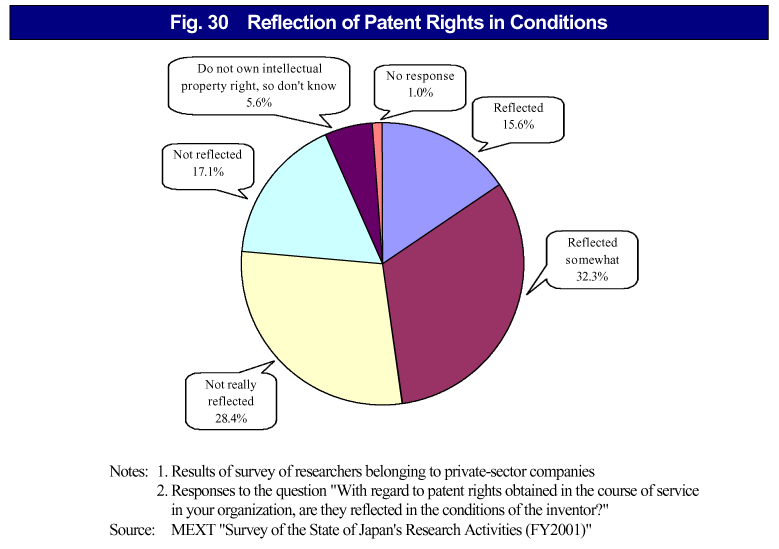
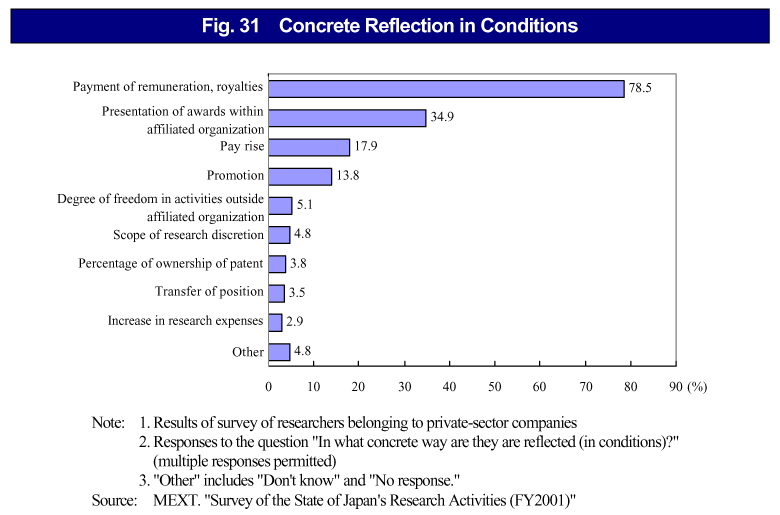
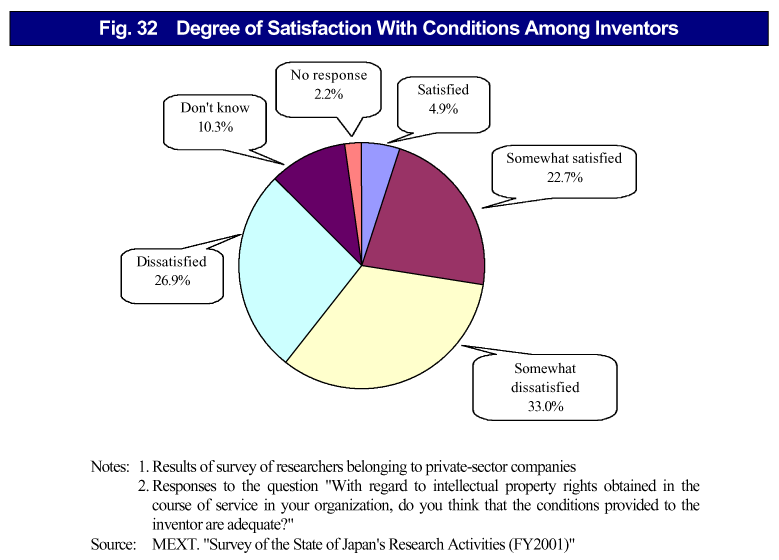
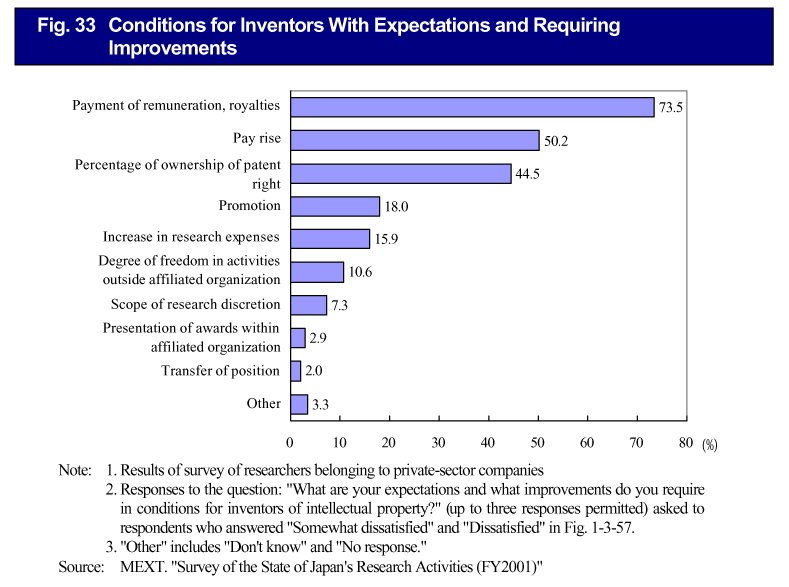
| (Treatment of University Patents) |
With regard to intellectual property of university researchers
too, the problem has been indicated that companies do not evaluate them adequately,
and in developing intellectual property strategies, it is necessary to spread
an awareness that recognizes the achievements of intellectual activities, and
evaluates them adequately.
In research and development, for intellectual achievements outside the major research achievements, such as material samples and biological genetic resources of mice and microbes, it is necessary to promote research that uses these achievements, and smoothly carry out technology transfer to industry.
| Back to Top | MEXT HOME |